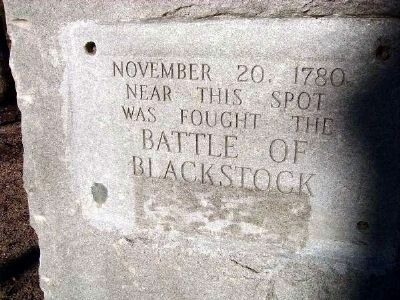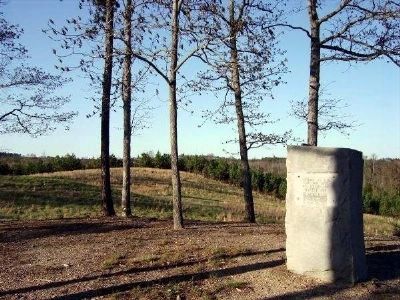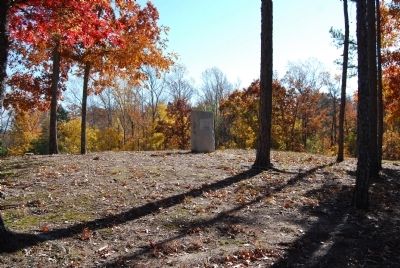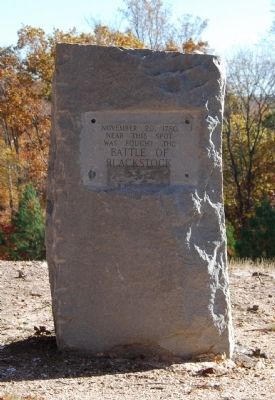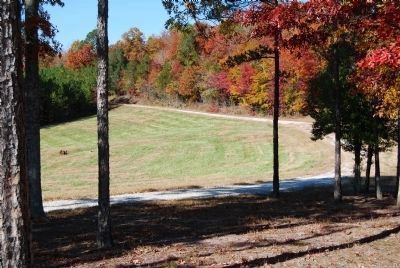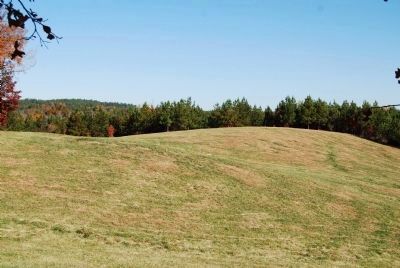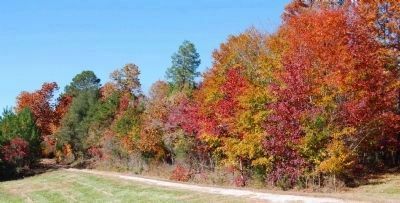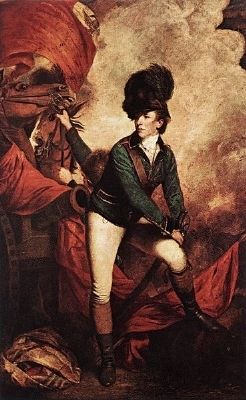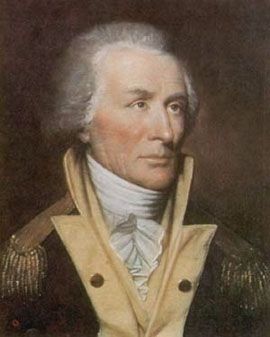Near Cross Anchor in Union County, South Carolina — The American South (South Atlantic)
Battle of Blackstock
Near this spot was fought the
Battle of
Blackstock
Topics. This historical marker is listed in these topic lists: Colonial Era • Patriots & Patriotism • War, US Revolutionary. A significant historical date for this entry is November 20, 1780.
Location. 34° 40.751′ N, 81° 48.902′ W. Marker is near Cross Anchor, South Carolina, in Union County. Marker is on Monument Road, 1.4 miles north of Blackstock Road. Marker is located in a grove of trees atop a hill about 1000 feet east of the parking area. Touch for map. Marker is in this post office area: Cross Anchor SC 29331, United States of America. Touch for directions.
Other nearby markers. At least 10 other markers are within 6 miles of this marker, measured as the crow flies. Battle of Blackstock’s (approx. 2.4 miles away); New Hope Baptist Church (approx. 3½ miles away); Cross Keys House (approx. 4 miles away); Padgett’s Creek Baptist Church (approx. 5½ miles away); Captain Shadrach Inman Memorial (approx. 5.7 miles away); Ready for the Enemy (approx. 5.7 miles away); The Main Event (approx. 5.7 miles away); Bloody Chaos (approx. 5.8 miles away); The Trap Is Sprung (approx. 5.8 miles away); The Enemy Within (approx. 5.8 miles away). Touch for a list and map of all markers in Cross Anchor.
Also see . . .
1. Battle of Blackstock's Historic Site. At Blackstock’s tobacco barn on the Tyger River, British troops under Colonel Banastre Tarleton battled with American militiamen under General Thomas Sumter on November 20, 1780. (Submitted on November 8, 2008, by Brian Scott of Anderson, South Carolina.)
2. Thomas Sumter. Thomas Sumter (August 14, 1734 – June 1, 1832) was a hero of the American Revolution and went on to become a longtime member of the Congress of the United States. (Submitted on November 8, 2008, by Brian Scott of Anderson, South Carolina.)
3. Banastre Tarleton. General Sir Banastre Tarleton, 1st Baronet, GCB (21 August 1754 – 16 January 1833) was a British soldier and politician. (Submitted on November 8, 2008, by Brian Scott of Anderson, South Carolina.)
4. Blackstock Battlefield, A Site on a Revolutionary Road Trip on US Route 221. Brigadier General Thomas Sumter, the “Gamecock,” along with Colonel Francis Marion, the “Swamp Fox,” were appointed Patriot militia leaders by the governor of South Carolina, John Rutledge. (Submitted on November 8, 2008, by Brian Scott of Anderson, South Carolina.)
Additional commentary.
1. Blackstock's Ford
Date: November 20, 1780
Location: Near Cross Keys, Union County
Commanders: Gen. Thomas Sumter; Col. Banastre Tarleton
Casualties; American - 3k, 4w; British - 92k, 75w
"With Patriot victories at King's Mountain and Fishdam Ford, Sumter's troops now numbered 1,000 and the Gamecock was ready to move against Ninety Six. In the meantime, Cornwallis called off Tarleton's fruitless pursuit of Francis Marion and sent him chasing after Sumter. With warning from a British deserter, Sumter instead turned west and was preparing to ford the Tyger River near Blackstock's Plantation. Knowing he would have to run to catch Sumter, Tarleton left his infantry and artillery behind and continued on with his cavalry.
"Sumter was ready for him. He posted his men behind the fence along the road to the fort as well as in Blackstocks' farmhouse and outbuildings. Realizing he was badly outnumbered and out positioned, Tarleton attempted to delay in order to wait for the rest of his troops and his artillery. But Sumter was well aware of his advantage and sent his men forward to initiate the battle. Unfortunately, the men fired at too great a distance and were charged by British bayonets before they could reload. But Hampton's sharpshooters, safely ensconced in the outbuildings, effectively reduced the force before they could inflict much damage.
"The British line broke and fell into retreat. They had lost 92 killed and 75 wounded. Sumter road forward to solidify his victory when a British unit covered the retreat saw him and fired. Sumter was wounded in six places by buckshot but managed to ride back to command post. He was tended by a surgeon at the Blackstock house and then carried off to the mountains on a bull's hide attached to poles and slung between two horses, to recover. He would be out of action for the next two months.
"Unwilling to admit defeat, the pompous Tarleton claimed victory. After all, he had prevented an attack on Ninety Six and Sumter's troops had dispersed after crossing the river. However, partisan forces nearly always dispersed after battle to reform when needed, and the boost in Patriot morale left no doubt as to who were the true victors. Patriot casualties were only three killed and four wounded." (Source: South Carolina's Revolutionary War Battlefield: A Tour Guide, (2002), R.L. Barbour, pages 68-69.)
— Submitted November 8, 2008, by Brian Scott of Anderson, South Carolina.
2. Battle of Blackstock’s Historic Site
The Blackstock’s battlefield is located south of the Tyger River, immediately east of the Spartanburg County line, in a hilly, wooded region. The smaller hill on those Blackstock’s barn was located is at the end of a dirt road leading from county road S-51. About 1500 feet from the Tyger River, this hill is designated with a marker. The large hill on which most of Sumter’s troops were stationed during the battle lies about 2,000 feet west of the historical marker. Two creeks run parallel to the road, one on either side, from the Tyger River.
The creek that the British crossed in attacking Blackstock’s is to the south of the road. In the eighteenth century much of the land along the road was cleared, but these fields have since been overgrown with small pines and brush. Originally, the road continued to a narrow bend in the Tyger River, crossed the river at a ford, and continued north. The portion of the road leading away from the ford on the north side of the river is still visible, but on the south side the road has veered to the east leading to the historical marker, and no longer reaches the river.
No above-the-surface evidence remains of Blackstock’s barn or house, which were located in the area of the marker, and there are no modern buildings in the area of the battlefield.
Significance
At Blackstock’s tobacco barn on the Tyger River, British troops under Colonel Banastre Tarleton battled with American militiamen under General Thomas Sumter on November 20, 1780. The superior marksmanship, defenses, and number of the Americans allowed to drive off the attacking British infantry and cavalry. Although the Americans dispersed and were unable
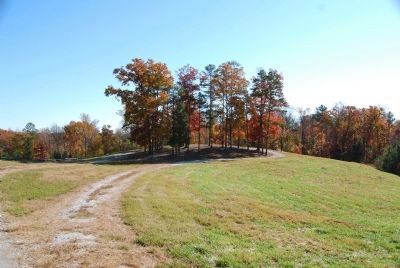
Photographed By Brian Scott, November 8, 2008
5. Site of the Battle of Blackstock’s
To reach the battlefield, take Blackstock Road northwest. At the fork, take the right (Battlefield Road). At the second fork, take the left (Monument Road). You will come to a parking area on the left. The battlefield is about 1,000 feet to the west. There is a stone monument on the hill top commemorating the battle.
In November 1780, General Thomas Sumter was moving southwesterly through upper South Carolina. His forces included a detachment of South Carolina militia which had been joined by troops from Georgia and North Carolina. Sumter’s plan was to move towards the British post of Ninety Six. Sumter, knowing of the Tory fort at William’s plantation on the Little River, established a temporary camp nearby on the Enoree River.
Lord Cornwallis, commander of British troops in the South, learned of Sumter’s movements towards Ninety Six on the 18th of November, picking up part of the 71st Regiment and the 63rd Regiment. Marching the next day and camping on the Enoree River, Tarleton hoped to surprise Sumter; however, a deserter from the 63rd Regiment warned Sumter’s men of Tarleton’s plans. On the morning of the 20th, sumter moved his men north to a defensive position at Blackstock’s on the south of the Tyger River.
Blackstock’s was the area of a large tobacco house and outbuildings a few hundred yards from the Tyger River. The house was located on one of a group of hills extending west from the river.
General
Sumter had about 600 men from the Carolinas and Georgia under the command of Colonels Twiggs and Elijah Clark of Georgia, and Colonels Henry Hampton, William Bratton, Thomas Taylor, William Hill, and James McCall of the Carolinas. Colonel Hampton occupied the tobacco house with his troops, and the Georgians covered the fence and woods south of the house along the edge of the field. Colonels Bratton, Taylor, Hill, and McCall were to occupy the high hill behind the house. Colonel Edward Lacey had a command of an advance force between the big hill and the river.
On the morning of the 20th, Colonel Tarleton received word of Sumter’s retreat to Blackstock’s and followed the South Carolina partisan leader. After crossing the Enoree River, Tarleton’s dragoons came upon a small detachment of Sumter’s rearguard, killing or capturing most of them and continuing his forced march until late afternoon. Fearing that Sumter would cross the Tyger River before dark, Tarleton left his unmounted infantry behind and continued with cavalrymen and mounted infantry. His plan was to engage the Americans with his advance troops, holding them until he Legion Infantry could arrive. Just before Tarleton’s horsemen arrived at the outskirts of Sumter’s camp, Colonel Thomas Taylor arrived at Sumter’s camp with wagons of supplies.
Tarlton, impressed with Sumter’s skillful deployment of his men in the hills, hesitated to attack, but was forced into battle as the advance Americans began to fire from the hills. The British 63rd Regiment Infantry, charged across the field from the creek, came under heavy fire from the soldiers in the log house, and suffered heavy losses.
Meanwhile, Colonel Lacey’s mounted infantry came through the woods on the west of the hill, firing into the British cavalry. Tarleton’s men advanced towards the ford, seeking to rescue the 63rd Regiment, but were hemmed in by American riflemen. They fell back, charged again, and were repulsed by American reserves. By nightfall, the fighting had ended, and the British had withdrawn.
Most of Sumter’s men dispersed north of the Tyger River, Sumter himself stopping at Berwick’s Iron Works with a small company. Colonel Clarke kept his men together, to eventually attack Ninety Six, and Colonel Lacey kept his mounted riflemen at a headquarters at Liberty Hill, in York County.
Tarleton’s soldiers crossed the Tyger the next day, but captured only a few American stragglers. After three days of searching, his soldiers returned to Blackstock’s and eventually to the Winnsboro area.
Believing that he had either successfully wounded or killed Sumter, Tarleton claimed a British victory. British losses in the battle were 50-100 killed, with an equal number wounded. Only a few Americans were killed or wounded. (Source: National Register nomination form.)
— Submitted August 6, 2009, by Brian Scott of Anderson, South Carolina.
3. Battle of Blackstock's now lives forever in our parks
Spartanburg Herald-Journal
Rachel Leonard, Staff Writer
November 20, 2008
On Saturday, campfires burned once again on the hills of what used to be Blackstock's farm in present-day Union County.
The fires stoked on that land 225 years ago today were left behind by victorious Patriot forces to trick the British into thinking they would fight Col. Banastre Tarleton a second day. The two campfires lit Friday served to roast venison and cornbread and heat chilly Revolutionary War buffs who stayed through the night, when the land became South Carolina's newest state park.
Revolutionary War re-enactors, historians and donors met at Blackstock's Battlefield Saturday morning to dedicate 107 acres of forest, grassy hilltops and riverfront property to the people of South Carolina.
"We promise to change people's lives based on what happened here today and what happened here 225 years ago," State Parks Director Phil Goins said after the land deed changed hands.
He pointed to a nearby cotton tent where children dressed in the clothing of the Revolutionary War period played next to a pair of horses.
"This is what it's all about," he said.
Nearly 100 British and only three Patriots were killed in the one-day fight, proving that militiamen fighting under Patriot Brig. Gen. Thomas Sumter could defeat "Bloody" Tarleton.
"The chink in his armor was shown here," said George Fields, director of the Palmetto Conservation Foundation's Military Heritage Program. "He could be beaten."
Reliving history
Re-enactor Howard Burnham, dressed as Sumter, "shared" the Patriot leader's memories of Blackstock's Saturday as he stood atop a tree-dotted knoll. With a long feather jutting from his tricorn hat, he described how his men took on the "red cockroaches" and how he was wounded, paving the way for Gen. Daniel Morgan.
"It was a satisfactory day's work," he concluded.
Sumter Chumley, a 7-year-old Reidville boy whose parents named him after the Revolutionary War hero, was impressed by his namesake's costume and "gentleman's" sword. In a small field, re-enactors on horseback demonstrated militia swordsmanship by lopping off the tops of cabbages placed on wooden posts.
Re-enactor Ron Crawley of Grambling, wearing a rifle frock, breeches and hat, brought his daughters Taylor, 5, and Hunter, 9. Taylor, wearing a dress and white bonnet, chewed on a blade of grass
while Hunter, dressed like her father, munched on a chunk of cabbage, her brown hair tied into a ponytail with a piece of twine.
The family camped on the battlefield overnight, telling stories and roasting marshmallows by the fire. "I just love to dress up and see other people and to actually feel like history," Hunter said.
Crawley began re-enacting Civil War battles, but he found the American Revolution suited him better. "The Revolution's all over the place here," he said. "It's the right era to be living in Spartanburg County."
The terrain where the Battle of Blackstock's raged is much like it was in 1780. There are no cell phone towers in sight. No sounds of highway traffic.
War artifacts already have been found on the site, including fired and unfired rifle balls, American and British musket balls and a musket ramrod pipe. Preserving the land has been a priority for Fields since 1997. The Palmetto Conservation Foundation, Union County, locals and private donors -- including International Paper and the Timken Foundation -- made it happen.
"It's really great to see the fruition of all this," said Allan Charles, a University of South Carolina Union history professor. "It's taken us a long time."
— Submitted August 6, 2009, by Brian Scott of Anderson, South Carolina.
4. Battle Of Blackstock's Anniversary Celebration 2009
On November 20, 1780, General Thomas Sumter and his men fought Lieutenant Colonel Banastre Tarleton and a small, but well trained force of British soldiers at the Blackstock's Plantation in modern-day Union County. On Saturday, November 21, 2009, Musgrove Mill State Historic Site will be presenting the Battle of Blackstock's Anniversary Celebration. The event will feature an interpretive talk on the Battle of Blackstock's and its significance, a Ranger-led tour of the battlefield, a period firing salute, and commemorations by the Daughters of the American Revolution and the Sons of the American Revolution. The event will be held at 1:00 pm at Blackstock Battlefield Historic Site. For more information and directions to Blackstock Battlefield Historic Site, contact Musgrove Mill State Historic Site at (864) 938-0100.
— Submitted November 8, 2008, by Brian Scott of Anderson, South Carolina.
5. William Blackstock
"William Blackstock was about 80 years old when the battle happened on his farm. He was a 'large, stout Irishman' who sided with the King during the war. L. Miles wrote 'When the British and Torts camped at his house or nearby, he used to pilot them to my father's to rob and plunder. I have heard my mother say the only way she could keep anything to eat was to put it in a jar in the jimb of the house and cover it with ashes.' Both of Blackstock's sons were in the Patriot militia. One of his sons, Captain William Blackstock, was not at the battle, but was with Roebuck's militia." (Source: Nothing But Blood and Slaughter: The Revolutionary War in the Carolinas, Volume Two: 1780 (2004), Patrick O' Kelley, page 555.)
— Submitted November 8, 2008, by Brian Scott of Anderson, South Carolina.
Credits. This page was last revised on November 27, 2020. It was originally submitted on September 6, 2008, by M. L. 'Mitch' Gambrell of Taylors, South Carolina. This page has been viewed 3,276 times since then and 36 times this year. Photos: 1, 2. submitted on September 6, 2008, by M. L. 'Mitch' Gambrell of Taylors, South Carolina. 3, 4, 5, 6, 7, 8, 9. submitted on November 8, 2008, by Brian Scott of Anderson, South Carolina. 10. submitted on August 6, 2009, by Brian Scott of Anderson, South Carolina. • Kevin W. was the editor who published this page.
